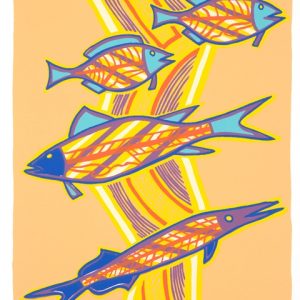Description
- Artist: Garry Djorlom
- Language group: Kunwinjku
- Clan: Born
- Lived: 1963 – 2017
- Screenprint – Edition of 250
- Size of image 16 x 23 cm
- Size of paper 25 x 35 cm
- Size of print with mat board and foamcore backing 28 x 38 cm
Garry was the son of Dudley Djorlom, a traditional bark painter who taught his son to paint on rock and on bark. He had a very good schooling in his youth, and took his promised wife, Doreen, when she was still in her early teens. As the son of a ceremonial leader he learnt the traditional way of life and was an excellent hunter and food gatherer. He appeared in several documentaries depicting both his talent as an artist, a dancer, and a hunter in the old way, using four-pronged fishing spears, and digging sticks for yams. Garry was respected as a master painter on bark and on Arches Rives paper. For a time he lived at a remote outstation called Gumarrirnbang, in the Stone Country between Oenpelli and Ramingining. This homeland centre is owned by an old man called Timothy Nadjowh who was a great artist.
Garry painted “Did the Moon Man”, the first story Timothy gave to him, and it was entered in the 1998 National Indigenous Heritage Art Awards held in Canberra in April, this painting went on to receive a highly commended award. He has also had exhibitions in Perth and Melbourne. Several of Garry’s paintings were in the Kluge Commission (1991-92) and featured in the book entitled: “Kunwinjku Art, the John W. Kluge Commission”. They are now housed at the Kluge-Ruhe Museum, University of Virginia.
Garry had a distinctive style, his figures had a particular sinuousness about them. In his later years he was an outstanding Senior Tour Guide and took many visitors up Injalak Hill. He also trained future generations of guides.
Kunwinjku art is part of the oldest continuous art tradition in the world. Ancestors of today’s artists have been painting the rock walls of West Arnhem Land for tens of thousands of years. The traditional palette of white, red, yellow and black comes from the ochre that naturally occurs in the region, although contemporary artists sometimes choose to paint in acrylics as well. Kunwinjku artists famously paint using either the traditional rarrk hatching technique, or the more contemporary and complex cross hatching technique which has been adapted from ceremonial painting. These lines are painted using a manyilk, which is a piece of sedge grass shaved down until only a few fibres remain.
Provenance: John Clark/Framed Gallery commissioned a set of 10 “Oenpelli Prints” in collaboration with Injalak Arts in 1999. The prints feature a range of classic themes.








